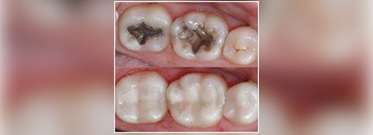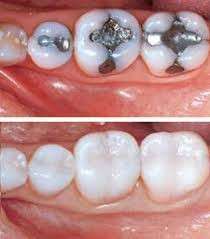
Are you searching for a dentist for tooth-colored fillings in Delhi? We offer painless dental fillings at low cost!
A cavity calls for removal of the decay and to fill in the tooth area that was removed in order to prevent further decay and strengthen the affected tooth. There have been lots of advances in modern dentistry that make this process much more comfortable and use materials that are safer and more aesthetically pleasing.
Tooth-colored fillings or resin dental fillings were created as an alternative to traditional metal dental fillings. These types of fillings are, durable and are way more natural-looking than silver amalgam fillings. Tooth Colored fillings are bonded to the tooth surface by n adhesive thereby preventing leakage at the tooth-filling border.
Silver Dental Fillings

Earlier the trend was to have amalgam fillings (silver) or gold filling restorations. These fillings contain mercury which is poisonous to the body as well as the environment. Also the amalgam fillings are generally not as advantageous as composite fillings because they demand more of a tooth removal and are susceptible to corrosion.
If you have a cavity in a tooth or broken fillings or if your teeth are full of silver fillings you may want to change to composite dental fillings. Silver fillings can easily be removed and replaced with far more attractive colored fillings by using safe silver amalgam removal protocol. Research shows that composite fillings actually strengthen your tooth and further protect it from decay.
Tooth-Colored Fillings FAQs
What are tooth-colored fillings?
Tooth colored fillings are resin fillings which match in color to the natural tooth shade.
How are tooth-colored fillings placed?
The tooth colored fillings are bonded to tooth surface using a special bond material.
What are the advantages of tooth-colored fillings?
Tooth colored fillings matches with the tooth shade- so the fillings appear esthetic. Secondly since the fillings are bonded to the tooth structure there is no leakage at the filling-tooth junction thereby elimination the possibility of tooth decay caused by leakage of fluids.
Are tooth-colored fillings durable?
Yes, modern tooth colored fillings are highly durable.
Can tooth-colored fillings stain?
Since tooth colored fillings are resin based, they can stain/discolor with time.
Do tooth-colored fillings require special care?
No special care is needed for tooth colored fillings except the normal routine oral hygiene measures such as brushing, flossing and mouth rinsing.
Can tooth-colored fillings be replaced with amalgam fillings?
Yes it is possible to replace amalgam fillings with tooth colored fillings.
What are silver dental fillings?
Silver dental fillings are silver amalgam based fillings which involve mixing of silver alloy with mercury.
Are there any concerns regarding the mercury in silver dental fillings?
The mercury content of silver fillings is highly toxic to the body. This mercury leaches out from the silver fillings in the form of a vapor whenever the temperature of the filling rises due to consumption of hot foods.
Do silver dental fillings require special care? No special care is needed for silver fillings.?
Can silver dental fillings cause tooth discoloration?
The corrosion products produced by reaction between saliva and silver alloy causes bluish black discoloration of the surrounding tooth structure.
Are silver dental fillings still commonly used today?
No due to the presence of mercury as a component of silver filling, use of silver fillings is banned.
Are tooth colored fillings safe?
Yes it is absolutely safe to go in for tooth colored fillings.
Can dentist hit a nerve when doing filling?
Yes particularly in cases where cavity is deep, it is possible to go close to a nerve during the filling procedure.
Safe Mercury Amalgam Removal Technique (SMART)
All dental amalgam restorations also called silver fillings, contain approximately 50% mercury, and reports and research are consistent that these fillings emit mercury vapors during brushing, cleaning, clenching of teeth, chewing, etc. and mercury is also known to be released during the placement, replacement, and removal of dental mercury amalgam fillings.

Scientific research demonstrates that dental mercury amalgam exposes dental professionals, dental staff, dental patients, and fetuses to releases of mercury vapor, mercury-containing particulate, and/or other forms of mercury contamination.
The IAOMT (International Academy of Oral Medicine and Toxicology) safe amalgam removal protocol recommendations were updated on July 1, 2016, and were officially renamed as the Safe Mercury Amalgam Removal Technique (SMART).
IAOMT recommendations include the following measures for the patient for Dental SMART Technique
-
- A dental dam is placed and properly sealed in the patient’s mouth.
- The patient is given a slurry of charcoal, chlorella, or similar adsorbent to rinse and swallow before the procedure (unless the patient declines or there are other contraindications making this clinically inappropriate).
- Protective gowns and covers for the dentist, dental personnel, and the patient should be in place.
- External air or oxygen delivered via a nasal mask for the patient also should be utilized to assure the patient does not inhale any mercury vapor or amalgam particulate during the procedure.
- A saliva ejector is placed under the dental dam to reduce mercury exposure to the patient.
- Copious amounts of water to reduce heat and a conventional high speed evacuation device to capture mercury discharges is used to reduce ambient mercury levels.
- The amalgam is sectioned into chunks and removed in as large of pieces as possible using a small diameter carbide drill.
- Once the removal process is complete, the patient’s mouth is thoroughly flushed with water and then rinsed out with a slurry of charcoal, chlorella or similar adsorbent.
IAOMT recommendations include the following measures for the dental clinic Dental SMART Technique
-
- An amalgam separator is used to collect mercury amalgam waste so that it is not released into the effluent from the dental office.
- Windows are opened and /or exhaust fans run to reduce the mercury concentration in the air.
- Non-latex nitrile gloves are utilized by the dentist and all dental personnel in the room.
- Face shields and hair/head coverings are utilized by the dentist and all dental personnel in the room.
- During the opening and maintenance of suction traps in operatory or on the main suction unit, dental staff utilizes the appropriate personal protection equipment described above.
